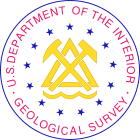
United States Geological Survey
Scientific agency of the US government / From Wikipedia, the free encyclopedia
Dear Wikiwand AI, let's keep it short by simply answering these key questions:
Can you list the top facts and stats about United States Geological Survey?
Summarize this article for a 10 year old
The United States Geological Survey (USGS), founded as the Geological Survey, is an agency of the United States government whose work spans the disciplines of biology, geography, geology, and hydrology. The agency was founded on March 3, 1879, to study the landscape of the United States, its natural resources, and the natural hazards that threaten it. The agency also makes maps of extraterrestrial planets and moons based on data from U.S. space probes.
 Seal of the United States Geological Survey | |
 Official identifier of the U.S. Geological Survey | |
 Flag of the United States Geological Survey | |
| Agency overview | |
|---|---|
| Formed | March 3, 1879; 145 years ago (1879-03-03) (as Geological Survey) |
| Jurisdiction | United States |
| Headquarters | John W. Powell National Center Reston, Virginia, U.S. 38.9470°N 77.3675°W / 38.9470; -77.3675 |
| Employees | 8,670 (2009) |
| Annual budget | $1.497 billion (FY2023)[1] |
| Agency executive | |
| Parent agency | United States Department of the Interior |
| Website | www |
The sole scientific agency of the United States Department of the Interior, USGS is a fact-finding research organization with no regulatory responsibility.[2] It is headquartered in Reston, Virginia, with major offices near Lakewood, Colorado; at the Denver Federal Center; and in NASA Ames Research Park in California.[3] In 2009, it employed about 8,670 people.[4]
The current motto of the USGS, in use since August 1997, is "science for a changing world".[5][6] The agency's previous slogan, adopted on its hundredth anniversary, was "Earth Science in the Public Service".[7]